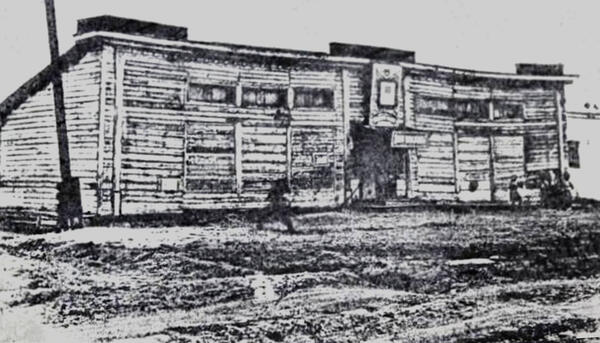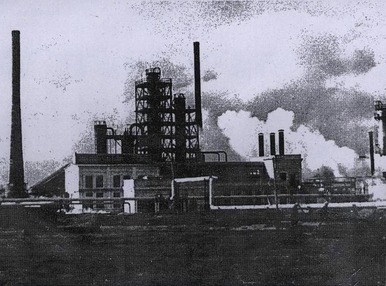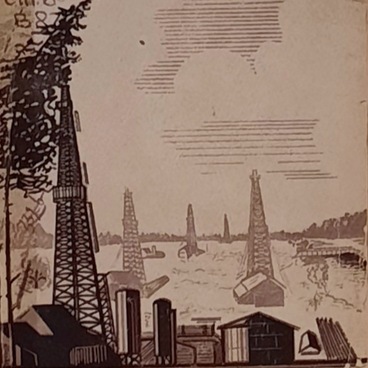After the 1932 discovery of BashkIr oil, Ishimbaevo began to rapidly grow as an oil settlement. During that time, small workers' settlements were popping up around it, with almost all of them, in one form or the other, later incorporating into the city of Ishimbay in 1940. This photo features the community center building of one such settlement, the village of Vyshstroy.
This is the community center of the local gasoline plant, which was fitted with a 90-seat auditorium, a small stage, and a tiny utility area. The center had a choir and a drama club. The choir and soloists performed unaccompanied, as the community center had no musical instruments. Later, a string and a brass orchestra did appear here after all, with their musicians playing their own instruments. In 1934, the community center established the first library in the area, which contained about 2,000 books; additionally, the building was expanded with a projection room. it also had Ishimbay’s first mobile cinema, which is a portable device for screening movies.
In 1949, the community center was closed due to the run-down state of its premises, so all its amateur performances had to move to the community center in the village of Peregonny. In 1961, a 200-seat movie theater was opened in a new building in place of the Vyshstroy community center. Since 2012, it has housed a branch of the Center for National Cultures, the Yondoz Cultural Center, which underwent major repairs in 2019.
Special emphasis has always been placed on the development of culture in the Ishimbay region, as at that time, the Soviet leadership believed that people who were building a new life would also need a new culture. The first head of the Vyshstroy community center’s administration was Usman Atkagulov, while Mussa Fatkullin was the first director of its Tatar-Bashkir drama club. Both died heroes in the Great Patriotic War.
Even in the first years of its existence, the Vyshstroy community center had drama, choreography, choir, and painting clubs, as well as brass and string orchestras. Very soon, the community center brought together a group of amateur performers, which numbered a little over 100 people. It successfully took on large artistic projects, such as staging performances of ‘The Bear’ and ‘The Proposal’ based on the plays by Anton Chekhov. During these years, what would later become the city of Ishimbay established its first cultural traditions, discovered new talents, and helped future cultural workers start their careers.
This is the community center of the local gasoline plant, which was fitted with a 90-seat auditorium, a small stage, and a tiny utility area. The center had a choir and a drama club. The choir and soloists performed unaccompanied, as the community center had no musical instruments. Later, a string and a brass orchestra did appear here after all, with their musicians playing their own instruments. In 1934, the community center established the first library in the area, which contained about 2,000 books; additionally, the building was expanded with a projection room. it also had Ishimbay’s first mobile cinema, which is a portable device for screening movies.
In 1949, the community center was closed due to the run-down state of its premises, so all its amateur performances had to move to the community center in the village of Peregonny. In 1961, a 200-seat movie theater was opened in a new building in place of the Vyshstroy community center. Since 2012, it has housed a branch of the Center for National Cultures, the Yondoz Cultural Center, which underwent major repairs in 2019.
Special emphasis has always been placed on the development of culture in the Ishimbay region, as at that time, the Soviet leadership believed that people who were building a new life would also need a new culture. The first head of the Vyshstroy community center’s administration was Usman Atkagulov, while Mussa Fatkullin was the first director of its Tatar-Bashkir drama club. Both died heroes in the Great Patriotic War.
Even in the first years of its existence, the Vyshstroy community center had drama, choreography, choir, and painting clubs, as well as brass and string orchestras. Very soon, the community center brought together a group of amateur performers, which numbered a little over 100 people. It successfully took on large artistic projects, such as staging performances of ‘The Bear’ and ‘The Proposal’ based on the plays by Anton Chekhov. During these years, what would later become the city of Ishimbay established its first cultural traditions, discovered new talents, and helped future cultural workers start their careers.



